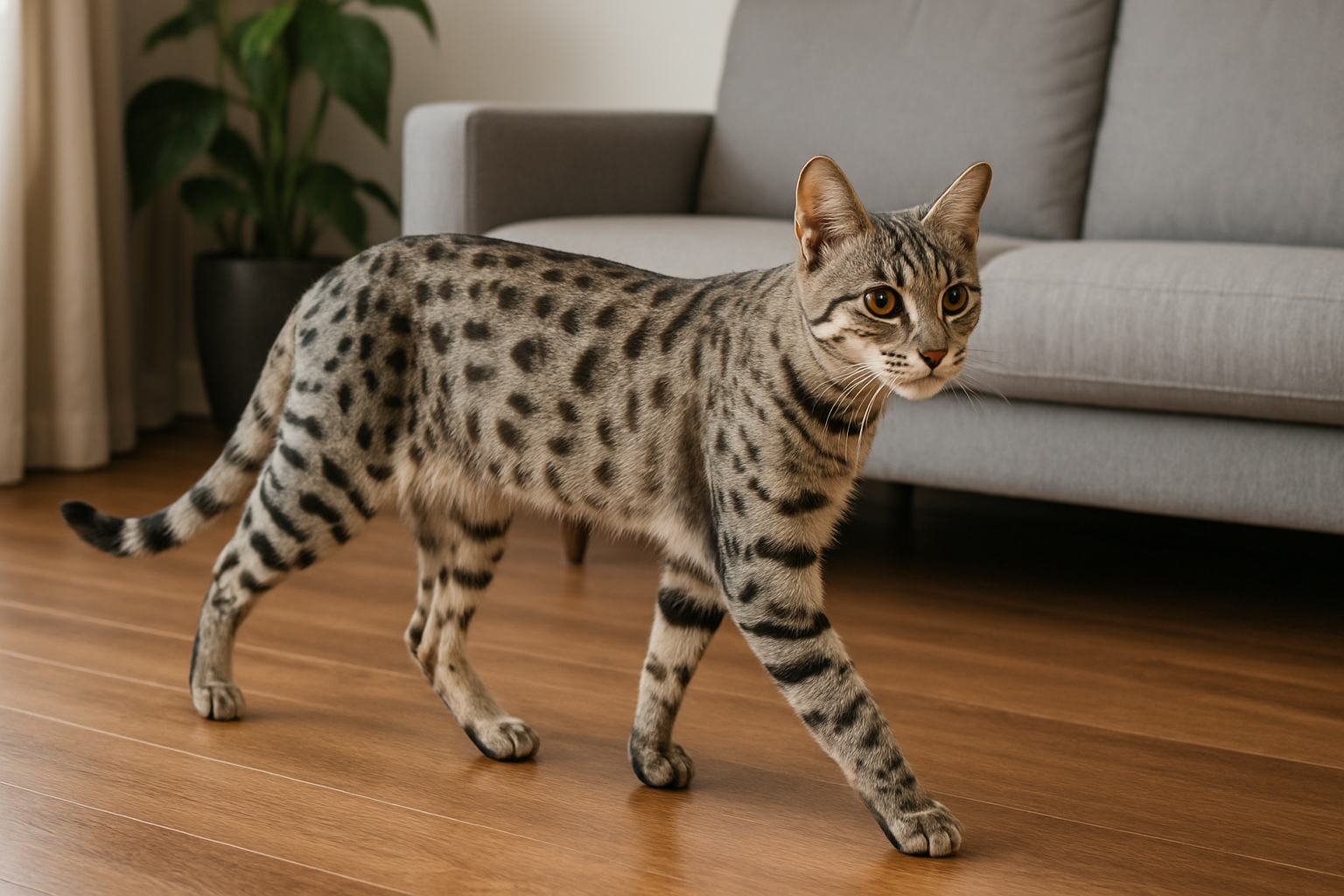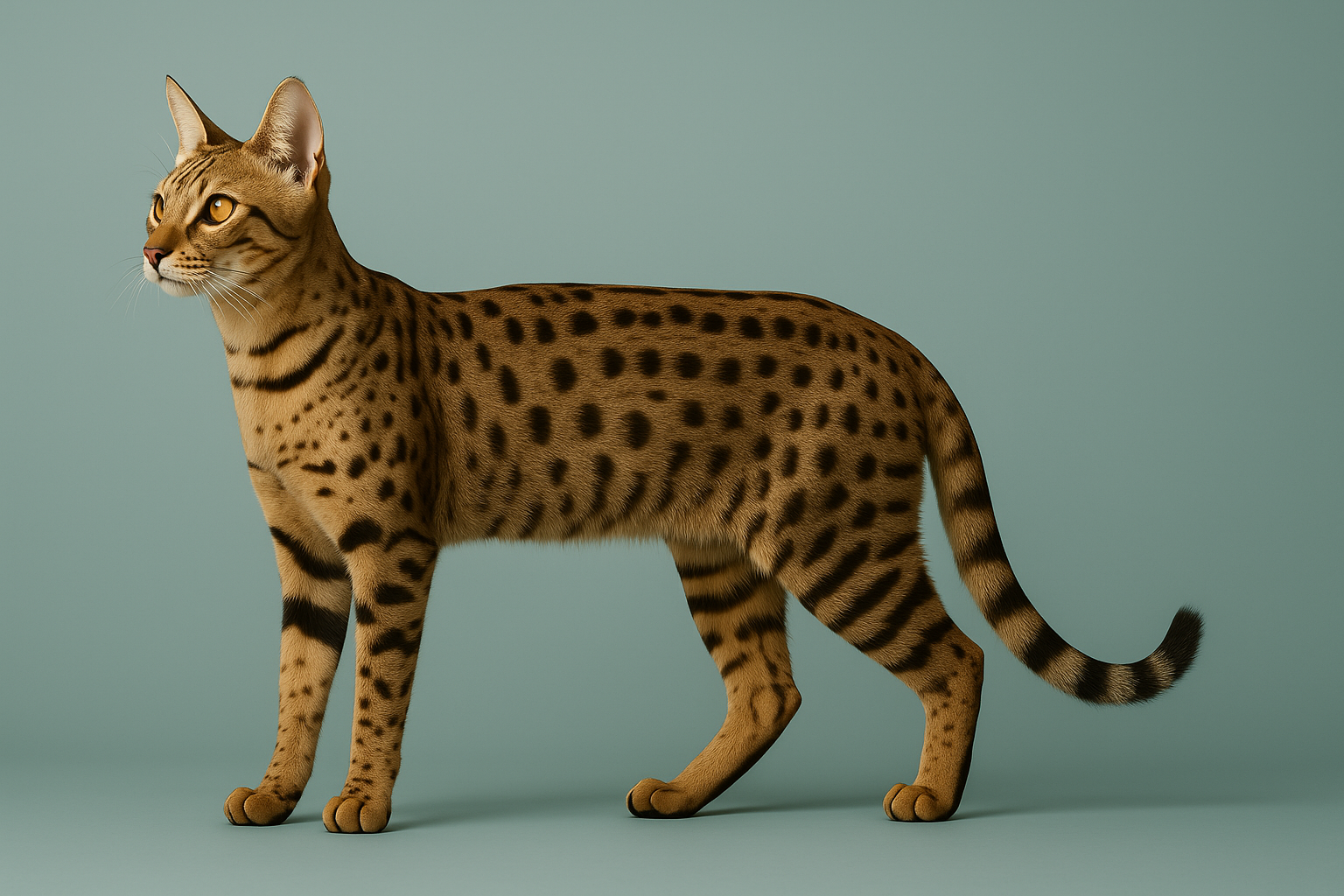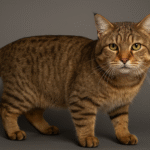With their long legs, wild-looking spots, and dog-like personality, the Savannah Cat is anything but ordinary. A hybrid of a domestic cat and an African Serval, this breed brings an exotic flair to everyday life, paired with a playful, intelligent temperament that keeps you on your toes. Whether you’re fascinated by their wild heritage or just want a smart, social feline companion, Savannah Cats are a breed like no other.
But owning a Savannah comes with some special considerations. From legal restrictions to energy levels, grooming needs, and even their specialized diet, these cats aren’t for everyone. If you’re curious about what it’s like to live with one—or just wondering how much a Savannah Cat costs—this guide has you covered.
Quick Breed Facts
- Origin: United States (hybrid of domestic cat and African Serval)
- Breed registries: TICA (The International Cat Association)
- Weight range: 12–25+ pounds depending on generation (F1–F5)
- Lifespan: 12–20 years
- Coat: Short, dense, and sleek
- Colors and patterns: Spotted tabby, black, silver, smoke, snow, and rare white
- Eye color: Gold, green, hazel; varies by coat color
- Grooming: Low-maintenance
- Activity level: Very high
- Affection level: High (especially with family)
- Vocality: Moderate to high
- Good with children: Yes, if socialized early
- Good with other pets: Sometimes (depends on generation and socialization)
History & Origin
The Savannah Cat is a hybrid breed that was first created in the 1980s by crossing a domestic cat with an African Serval—a tall wild cat known for its long legs and bold spotted coat. The first recorded Savannah kitten was born in 1986. It had the exotic look of a Serval but the personality of a tame house cat. By the early 2000s, the breed had started gaining attention and was eventually recognized by TICA.
Breeders went on to develop several generations, starting with the wild-looking F1 Savannah (which is 50% Serval). Later generations like F3, F4, and F5 became more popular as pets. These cats still carry the beauty and brains of their wild ancestors—but with personalities that work better in most homes.
Savannah Cat Personality & Temperament
Savannah Cats are known for their high intelligence and strong bonds with people. They often act more like dogs than typical cats. Many can learn to walk on a leash, play fetch, or even open cabinets. They’re not lap cats in the usual sense, but they love to follow you around, talk to you with chirps or meows, and stay involved in your daily life.
This breed is very social and needs lots of attention and playtime. Without it, they may get bored and cause mischief. Savannahs do best with families who have time to keep them active and mentally busy. They’re incredibly loyal, though some—especially early generations like F1 or F2—can be shy around strangers.
Savannah Cat Appearance & Coat
The Savannah Cat’s wild look is a big part of their appeal. They have tall ears, long legs, lean bodies, and bold spotted coats. Their heads are slightly smaller compared to their bodies, with large, expressive eyes and a curious, exotic expression. Their coats are soft, short, and usually covered in dark spots over gold, silver, smoke, or black backgrounds.

Color variations like the black Savannah Cat or even the rare white Savannah Cat do exist, but the classic spotted coats are still the most popular. Their athletic bodies help them leap high—some Savannahs can jump over six feet from a standing position!
Activity & Play
If you’re bringing home a Savannah Cat, be ready for action. This breed is loaded with energy and needs more than just a feather wand to stay happy. These cats love to sprint, climb, leap, and explore—and they’re not shy about finding creative ways to do it. Expect them to scale bookcases, perch on top of cabinets, or zoom through the house in a spontaneous game of tag.
They thrive with vertical space, so a tall cat tree or wall-mounted shelves are essential. Many Savannah owners also invest in catios or safe outdoor enclosures to let them stretch those long legs. Because they’re so smart, they also enjoy puzzles, training sessions, and learning tricks (yes, really). A bored Savannah is a mischievous one—so enrichment isn’t optional.
Grooming & Care
Savannahs are easy to groom thanks to their short coats. A quick brush once a week is usually enough to remove loose hair and keep their fur shiny. They don’t shed much and rarely need baths—unless they’ve been outside exploring.
Like all cats, they still need regular nail trims, ear checks, and dental care. Just know that Savannahs are energetic and may not enjoy sitting still for long. Starting grooming routines when they’re young makes a big difference.
Savannah Cat Health & Lifespan
Most Savannah Cats are pretty healthy, especially F4 and later generations. With good care, many live between 12 and 20 years. Like all cats, they can have some health issues—especially if they come from poor breeding practices.
Two things to watch for are PRA (Progressive Retinal Atrophy) and HCM (Hypertrophic Cardiomyopathy), both of which can affect any cat, hybrid or not. Regular vet visits, vaccines, and flea prevention go a long way toward keeping your Savannah happy and healthy.
Family Compatibility
If you’re looking for a cat that acts a little like a dog, the Savannah might be your perfect match. These cats are playful, loyal, and form strong bonds with their people. They’re usually great with older kids, but their size and energy might be too much for toddlers or very young children.
It’s important to socialize Savannahs early, especially if they’re higher-generation (like F1 or F2). Introducing them to other pets, people, and household sounds while they’re young helps them grow into more adaptable adults. Some Savannahs may not get along with other cats or small pets—especially if they weren’t raised together.
Recommended Supplies
Because of their size and energy, Savannah Cats do best with sturdy furniture, interactive toys, and a high-quality diet. Look for extra-large litter boxes, tall scratching posts, and spacious cat trees that can handle leaping and climbing. These cats need room to move!
They’re also incredibly smart, so pick toys that make them think—like puzzle feeders, wand toys, or motion-activated games. A bored Savannah can easily get into trouble, so rotating toys and adding new challenges will keep things fun for both of you.
Savannah Cat FAQs
How much is a Savannah Cat?
The Savannah Cat price depends mostly on the generation. F1 Savannahs (with the most Serval DNA) can cost between $10,000 and $20,000. F5 Savannahs, which are more common as pets, usually range from $1,000 to $4,000. The closer a cat is to its wild Serval ancestor, the rarer—and more expensive—it tends to be.
Are Savannah Cats hypoallergenic?
Not officially, but many people with allergies say they react less to Savannahs than to other cats. They have short coats and produce less dander, which may help reduce allergic reactions—though no cat is completely allergen-free.
Are Savannah Cats dangerous?
Most Savannahs are not dangerous at all. However, early-generation cats (like F1 or F2) can be more energetic and unpredictable, so they’re better suited to experienced owners. Later generations like F4 and F5 are usually just as friendly and trainable as other domestic cats.
What do Savannah Cats eat?
They thrive on a meat-rich, high-protein diet. Many breeders recommend raw or freeze-dried raw food, but good-quality grain-free kibble or wet food can also work well. Talk to your vet to find the best diet for your cat’s needs and activity level.
How big do Savannah Cats get?
It depends on the generation. F1 Savannahs can reach 20–25 pounds and stand over 16 inches tall at the shoulder. F4 and F5 generations are usually smaller—around 12 to 18 pounds—but still tall and lean with long legs and athletic builds.
Savannah Cat vs Bengal: What’s the Difference?
Savannah Cats tend to be taller and have a more exotic, serval-like build, while Bengal Cats are more muscular with bold, leopard-style rosettes. Bengals are generally more social and vocal, while Savannahs can be more independent and bond closely with one person.
Is a Savannah Cat Bigger Than a Maine Coon?
Savannahs are usually taller and leggier, but Maine Coons are heavier and more muscular. A large male Maine Coon may outweigh most Savannahs, though the Savannah often looks taller due to its long limbs and lean build.
Is the Savannah Cat Right for You?
If you’re looking for a quiet lap cat, the Savannah may not be your best bet. But if you love high-energy pets, have time to play every day, and don’t mind the occasional high jump onto your cabinets, a Savannah Cat could be your perfect match. They’re bold, affectionate, and form deep bonds with their humans.
Just make sure to check the laws in your area. Some places restrict ownership of hybrid cats, especially early-generation Savannahs like the F1 or F2. And always work with a responsible breeder who puts health and ethical practices first.







